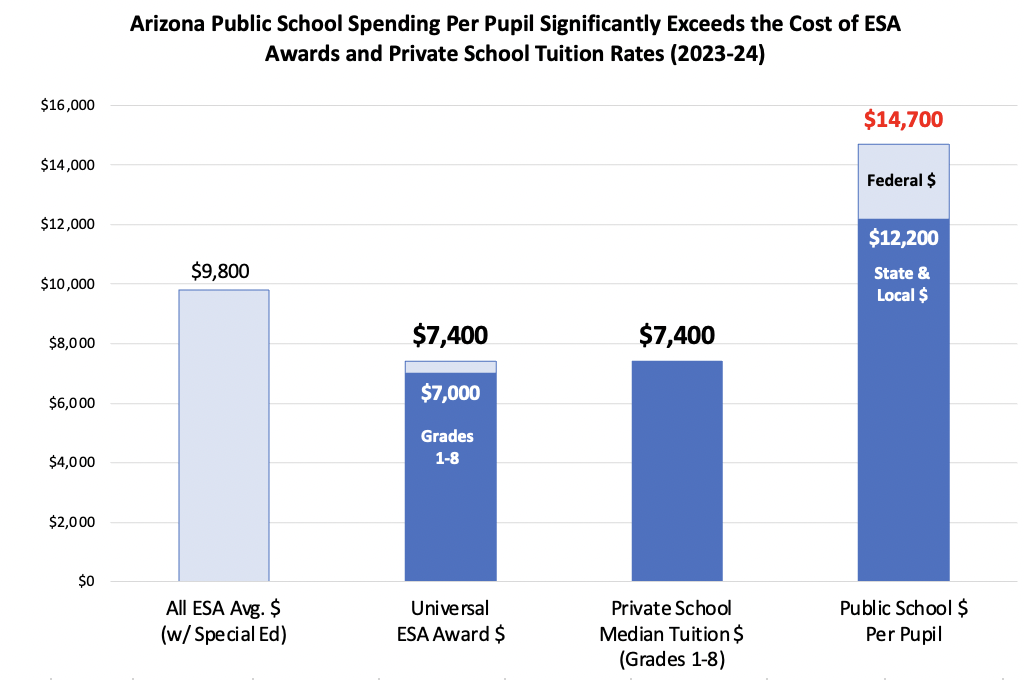Introduction & Executive Summary
In 2022, Arizona state lawmakers expanded eligibility for the Empowerment Scholarship Account (ESA) program to create the nation’s first fully universal education savings account program accessible to every K-12 student in the state—allowing families to redirect a portion of their children’s allocated state education funding toward private school tuition, tutoring, special needs therapies, and more. Since that time, ESA enrollment has soared to over 70,000 students, and states across the nation have looked to Arizona for evidence and inspiration when crafting their own policies to promote educational freedom.
This report offers the first direct, substantive analysis of the impact of universal ESA eligibility on the affordability of private education. Among its key findings, this report documents the following:
- The typical ESA award covers nearly 100% of tuition at the majority of private K-8 schools in Arizona. The baseline ESA award level of $7,000+ per child compares to the median elementary and middle school tuition rate of $7,400 as of 2023-2024.
- Private schools in Arizona did not significantly increase their tuition rates in response to the universal ESA expansion. After accounting for the U.S. inflation rate over the same period, median private school tuition rates rose yearly between 0.25% and 1.25% (depending on grade level) in real terms over the course of the 2022-2023 and 2023-2024 school years. Compared to the Phoenix metro area inflation rate, median private school tuition rates actually declined in real terms over the same period.
- Tuition rates at Arizona private schools rose less than per-pupil spending at Arizona public schools in response to universal ESA expansion. Despite claims that ESAs would trigger dramatic tuition inflation among private schools, it is public schools that have continued to raise the costs of education most rapidly. Comparing pre- and post-universal ESA expansion, the median private elementary and middle school tuition increase over two years ($1,050) is significantly less than the officially projected increase ($1,500) in per-pupil spending on Arizona public schools over the same period.
- Universal ESA expansion dramatically increased the affordability of private education for middle class and lower-income families. For each newly eligible ESA participant, a family can now receive over $7,000 of annual award funding to put toward private education, compared to a national inflation-driven increase in Arizona private school tuition of just $1,050 over the past two years.
- ESAs and private education remain significantly less costly to state taxpayers than the public school system at all grade school levels. The typical ESA award (over $7,000) and the median private elementary and middle school tuition rates ($7,400) are several thousand dollars less than taxpayers’ per-pupil spending on Arizona public schools (over $14,000).
- Various private schools explicitly advertise their tuition rates as less than the ESA award amount, ensuring parents have additional ESA funds to put toward extra tutoring, transportation, or other supplementary uses for their children.
- Universal ESAs have already led to the establishment of new high-quality educational offerings, including multiple new campuses operated by one of the state’s highest academically performing public K-12 charter networks, Great Hearts.
Background
In 2005, the Goldwater Institute proposed the nation’s first K-12 education savings account (ESA) program,[i] and in 2011—following the Institute’s blueprint[ii]—Arizona became the first state to enact such legislation, christening the new Empowerment Scholarship Account program. Though accessible only to certain student populations at the time, Arizona’s ESA program began serving thousands of families each year—allowing them to redirect their child’s allocation of state funding to private school tuition, tutoring, textbooks, at-home curriculum, and special needs therapies.
In 2021—prior to universal expansion—the Goldwater Institute released a detailed study of the ESA program and private school tuition rates in Arizona as of the 2021-2022 school year: A Decade of Success: How Arizona’s Empowerment Scholarship Accounts Have Saved Students and Inspired a National Movement.[iii]
This report highlighted the exponential growth and popularity of the ESA program during its first 10 years of existence while also demonstrating the financial significance of ESA support for families seeking private or at-home educational options. In particular, the report found that the typical ESA award—roughly $6,400 at the time for non-special education students—brought private education within financial reach of even the most economically disadvantaged families by nearly or fully covering tuition at most private Arizona elementary and middle schools, where the median tuition rates were approximately $6,500.
Following the issuance of that report, state lawmakers expanded Arizona’s ESA eligibility in 2022 to create the nation’s first fully universal program accessible to every K-12 student in the state. In the wake of that expansion, proponents and critics have clashed over predictions and portrayals of the program’s impacts, including its effects on the affordability of private education and the tuition rates charged by private school operators.
As Heritage Foundation researchers Jay Greene, Ph.D, Jason Bedrick, and Lindsey Burke, Ph.D, found in August 2023:
Data analysis from the past decade reveals that [private school] tuition inflation was lower in states that adopted school choice policies (about 15% on average) than in states without school choice (about 28%, on average). Moreover, among states that adopted school choice, inflation-adjusted tuition rates decreased after adoption of school choice. Contrary to the claims made by critics, states that adopted school choice had lower private-elementary-school tuition increases, and no discernable change in private-high-school tuition rates.[iv]
Such findings strongly indicate that school choice programs increase the affordability of private education rather than simply inflating the sticker price of tuition.
School choice opponents, however, have lined up to declare Arizona’s ESA program an exception to this rule. As the activist organization Save our School Arizona declared in 2023, “private schools across the state are hiking their tuition prices—making them inaccessible to low-income families.”[v] The state teachers union chapter, the Arizona Education Association, likewise echoed that “most AZ families have no way to cover $16,000 in annual tuition even with a voucher. It’s a scam. Always was!”[vi] Both organizations cited claims from the left-leaning Hechinger Report, which declared in November 2023:
A Hechinger Report analysis of dozens of [Arizona] private school websites revealed that, among 55 that posted their tuition rates, nearly all raised their prices since 2022. Some schools made modest increases, often in line with or below the overall inflation rate last year of around 6%. But at nearly half of the schools, tuition increased in at least some grades by 10% or more. In five of those cases, schools hiked tuition by more than 20%.[vii]
While this report itself acknowledged that such significant tuition increases were found among fewer than 1 in 10 surveyed institutions, the outlet summed up its desired narrative nonetheless as “Arizona gave families public money for private schools. Then private schools raised tuition.”
As the following sections illustrate, however, a more comprehensive analysis of Arizona private school tuition rates makes clear that such narratives fall badly short of reality.
ESAs Make Private School Affordable for All
Using 2023-2024 tuition and fee data collected in the fall of 2023 on 161 private K-12 schools in Arizona, this report provides the most robust analysis of the state’s current private school landscape available.[viii] Specifically, this report finds that the median private school tuition rate for elementary schools (grades 1-5) and middle schools (grades 6-8) is approximately $7,400.
In comparison, the baseline ESA award value for non-kindergarten, non-special education students is approximately $7,000 for elementary and middle school students and $7,800 for high school, with a median ESA award value of $7,400 overall[ix]. This means that the typical ESA award nearly or fully covers tuition and fees at the majority of private elementary and middle schools in the state, as shown in Figure 1. Even families with limited or near-zero ability to pay any out-of-pocket tuition costs are thus able to afford most private elementary and middle schools through the ESA program.
Figure 1
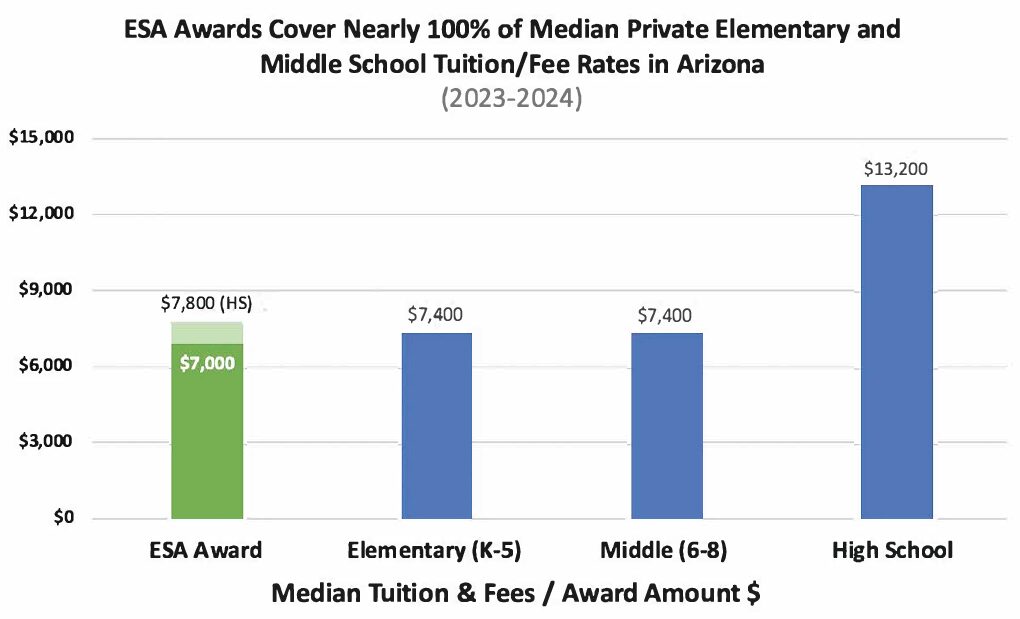
Source: Private school tuition and fee rates as reported on school websites or retrieved by request in fall 2023. Surveyed institutions include private schools independently identified as serving students in grades 1-12 in Arizona or included in the Private School Universe Survey, conducted by the National Center for Education Statistics within the U.S. Department of Education, with enrolled students in grades 1-12, excluding programs that serve only kindergarten or special education pupils. ESA award values reflect baseline ESA award values for non-kindergarten, non-special education participants for students in grades 1-8 ($7,000) and 9-12 ($7,800). Data reflects results from 141 schools serving students in grades 1-5, 127 schools serving students in grades 6-8, and 55 schools serving students in grades 9-12 (161 distinct institutions).
While median private high school tuition and fee rates ($13,200) remain significantly higher than the typical ESA award, this data suggests that families seeking to establish a stronger educational foundation—particularly in the K-8 grade range—via private education now have the means to do so with an ESA, regardless of the family’s wealth or income.
Moreover, many of largest, highest-performing Arizona private high schools explicitly offer other financial assistance through programs such as the Arizona school tuition organization (STO) tax credit for lower-income students, ensuring that affordability remains within reach throughout grade levels. The Brophy Community Foundation, for instance—associated with Brophy College Preparatory, one of the highest academically performing private high schools in the state, where tuition and fees exceed $18,500—reports that the average family income of recipients who received tuition assistance in 2022-2023 was $45,500.[x]
Additionally, while critics typically seek to portray private schools as prohibitively costly to all but the most affluent families—even after available ESA assistance—this report makes clear that the reverse is true. Figure 2 shows the distribution of private elementary schools in Arizona by tuition and fee rates, compared to the state’s baseline ESA award value. As clearly evident, the largest share of private elementary schools in Arizona offers tuition rates at, near, or below the value of a typical student’s ESA award.
Figure 2
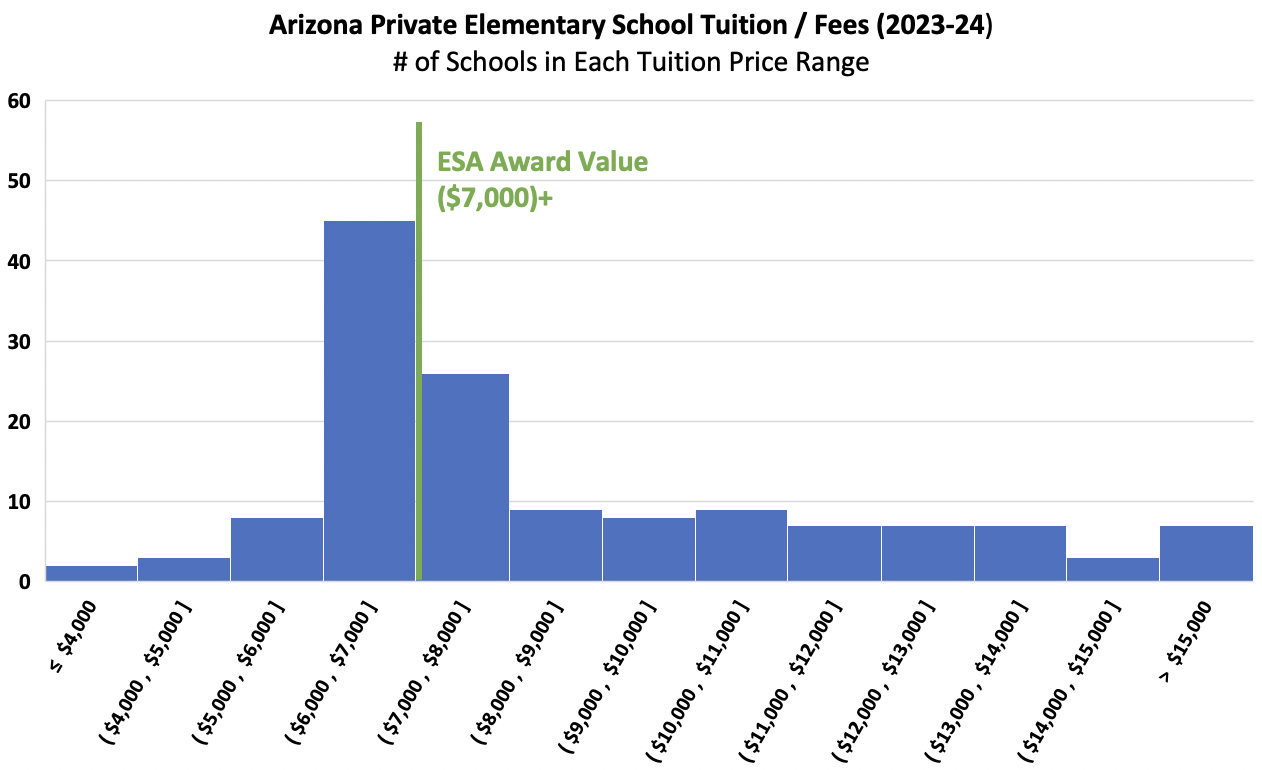
Source: Private school tuition and fee rates as reported on school websites or retrieved by request in fall 2023. Surveyed institutions include private schools independently identified as serving students in grades 1-12 in Arizona or included in the Private School Universe Survey, conducted by the National Center for Education Statistics within the U.S. Department of Education, with enrolled students in grades 1-12, excluding programs that serve only kindergarten or special education pupils. ESA award value reflects baseline ESA award values for non-kindergarten, non-special education participants in grades 1-8. This amount understates the value of ESA awards for thousands of elementary and middle school students who receive additional non-special education funding weights under the state education finance formula. Tuition data reflect results from 141 schools serving students in grades 1-5.
Impact of Universal ESAs on Private School Tuition Rates
While this report demonstrates that universal ESAs have made private education affordable to virtually all Arizona families regardless of income, the data also reveals another significant finding: Private schools in Arizona did not significantly increase their tuition rates in response to the universal ESA expansion.
The median tuition increase among Arizona private elementary schools from 2021 to 2023 was $1,050 (or approximately $500 a year). Among middle schools, likewise, the median tuition increase over two years was $1,065.[xi]
These increases may at first glance appear significant—constituting a 14.7% median rise in tuition prices from 2021 to 2023 at the elementary level, for instance. However, when compared to overall economic trends—specifically local and national inflation rates and the increases in the state’s public school spending rates per pupil over the same period—the impact of universal ESA expansion on tuition rates appears extremely modest, if not almost entirely absent.
For example, inflation in the U.S. over the same period brought a 12.2% increase in prices generally,[xii] meaning that the nominal 14.7% rise in tuition prices constituted just a 2.5% increase in real terms (or roughly 1.25% annually).[xiii]
Perhaps even more significantly, as shown below in Figure 3, the median shift in Arizona private school tuition rates actually amounted to a decrease when compared to Arizona-specific inflation trends. Over the same two-year period that Arizona private elementary school tuition rates rose by a median of 14.7%, the Phoenix-Mesa-Scottsdale metropolitan area registered a 17.2% increase in prices.[xiv] Given that over half of the surveyed schools are located in the metro Phoenix area, this strongly suggests that private school tuition rates often fell in real terms, even amid universal expansion of ESAs.
Figure 3
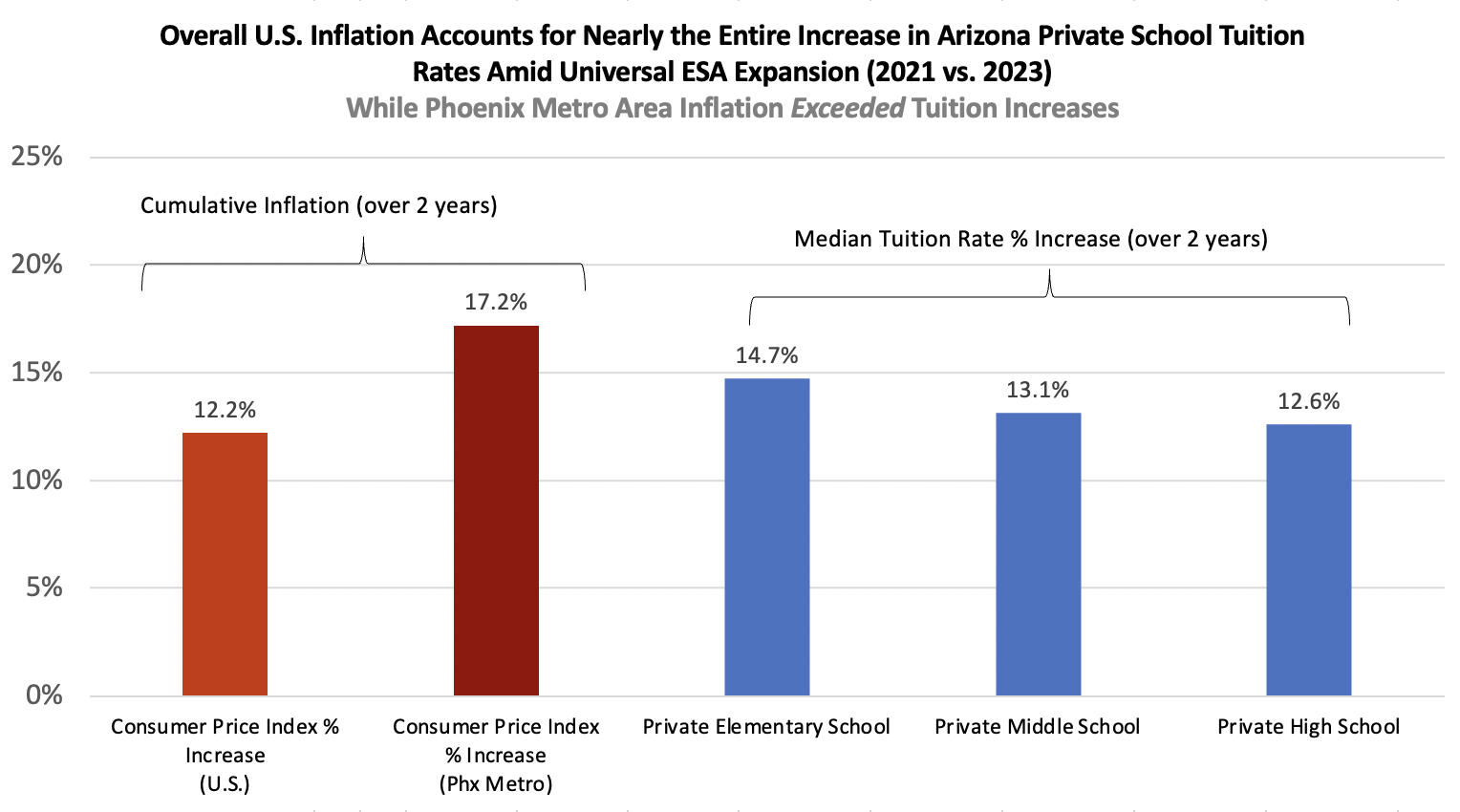
Source: Analysis of United States Bureau of Labor Statistics Consumer Price Index for All Urban Consumers (CPI-U), All Items in U.S. City Average, and All Items in Phoenix-Mesa-Scottsdale, AZ, All Urban Consumers, Not Seasonally Adjusted, August 2021 and August 2023; analysis of change from 2021 to 2023 in tuition and mandatory fees from 141 schools serving students in grades 1-5, 127 schools serving students in grades 6-8, and 55 schools serving students in grades 9-12 (161 distinct institutions).
Moreover, contrary to the claim that ESA expansion has triggered a massive spike in private school tuition costs, tuition rates at Arizona private elementary and middle schools rose less than per-pupil spending at Arizona public schools between 2021 and 2023. Comparing pre- and post-universal ESA expansion, the median private elementary and middle school tuition increases over two years ($1,050 and $1,065, respectively) are significantly less than the officially projected $1,554 increase in per-pupil spending on Arizona public schools over the same period, as shown in Figure 4.
Figure 4
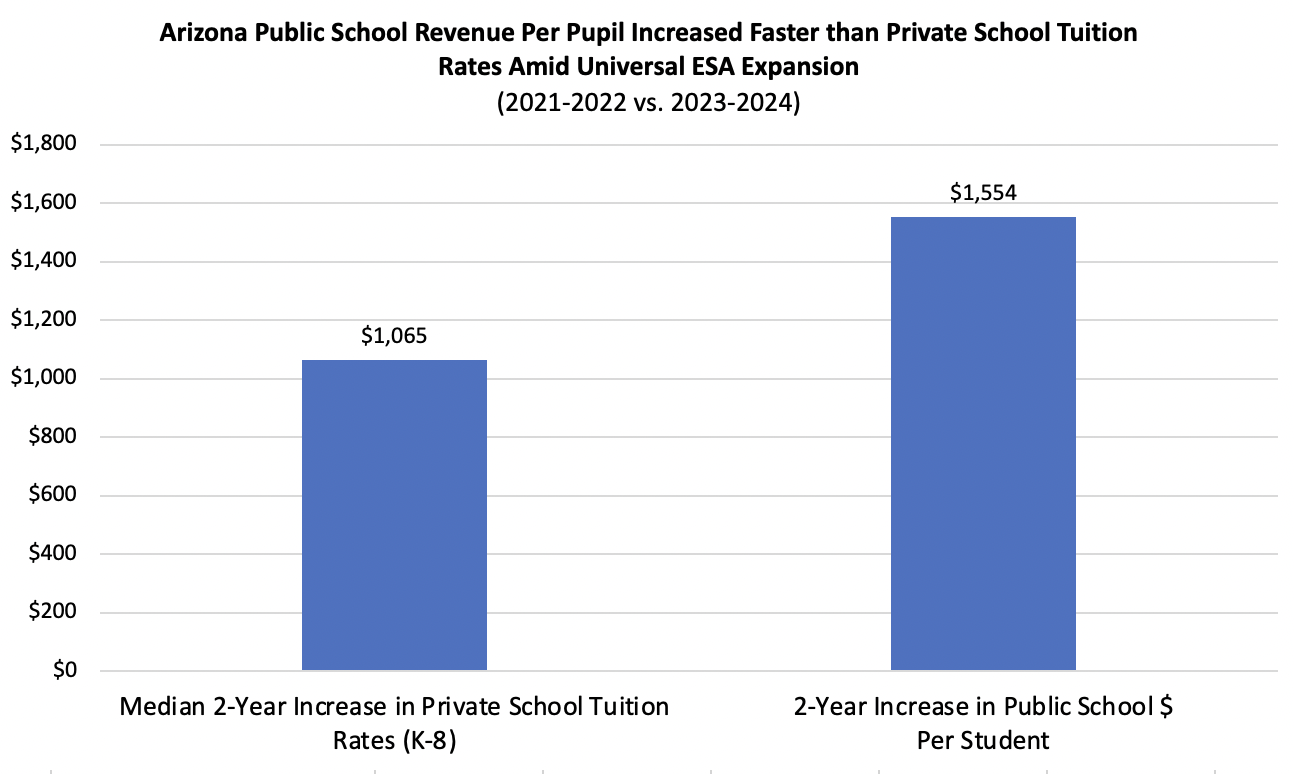
Source: Private school tuition and fee rates as reported on school websites or retrieved by request in 2021 and 2023. Surveyed institutions include private schools independently identified as serving students in grades 1-12 in Arizona or included in the Private School Universe Survey, conducted by the National Center for Education Statistics within the U.S. Department of Education, with enrolled students in grades 1-12, excluding programs that serve only kindergarten or special education pupils. Data reflects results from 141 schools serving students in grades 1-5 and 127 schools serving students in grades 6-8 (with overlapping totals). Median tuition rate increase for grades K-5 was $1,050. Median tuition rate increase for grades 6-8 was $1,065. Change in public school funding per student based on the difference between 2021-2022 and estimated 2023-2024 state and local funding per pupil, as reported by the Arizona Joint Legislative Budget Committee “All Funding” report (August 9, 2023).
Specifically, the state’s nonpartisan Joint Legislative Budget Committee reports that per-pupil public school funding from state and local taxpayers alone (excluding federal tax revenues) is estimated to have increased from $10,657 in 2021-2022 to $12,211 as of 2023-2024.[xv]
Public School Spending Continues to Outpace ESAs and Private School
Including federal revenues, Arizona public school funding per pupil is projected to reach $14,657 in 2023-2024—nearly twice the cost to taxpayers of the $7,400 median ESA award and nearly twice the cost of the median private elementary and middle school in Arizona, as shown in Figure 5.[xvi]
Figure 5
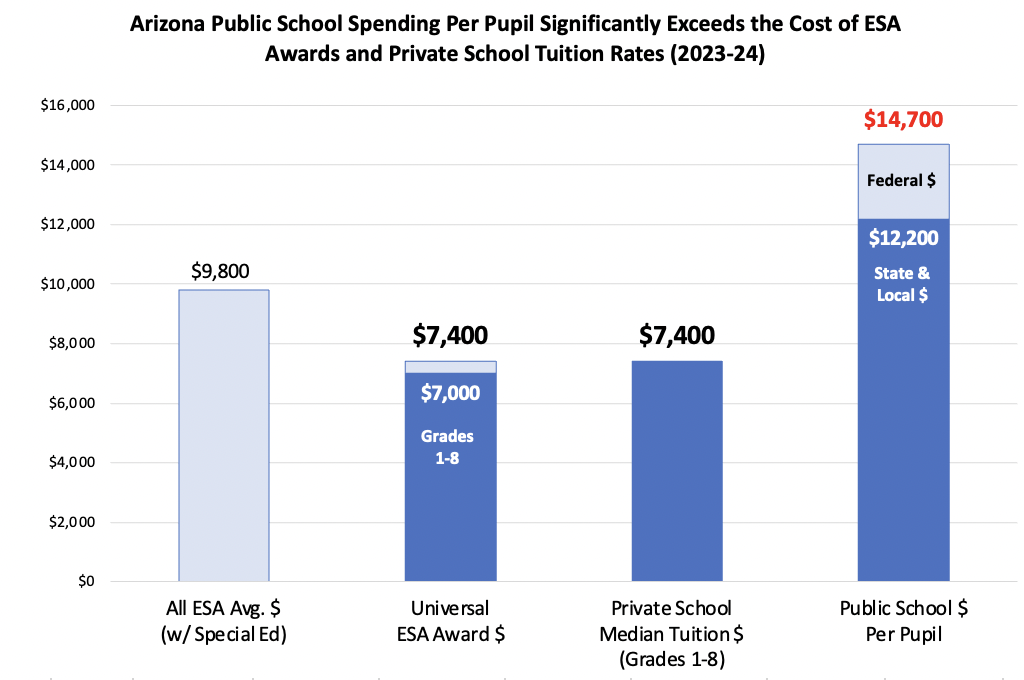
Source: Universal ESA award value per student reflects baseline ESA award values for non-special education students in grades 1-8: $7,000, as well as reported ESA median award amount for all grade levels as documented in Arizona Department of Education 2023-2024 Quarter 1 Report. Award value for “All ESAs” reflects average ESA award as reported by Arizona Department of Education, including special education students, who can receive significantly more in funding per pupil. Median private school tuition data reflect results from 141 schools serving students in grades 1-5 and 127 schools serving students in grades 6-8 (overlapping institutions), excluding special education based programs. Estimated 2023-2024 public school funding per pupil as reported by the Arizona Joint Legislative Budget Committee “All Funding” report (August 9, 2023). Estimates display funding from all sources (state, local federal), and state and local only.
At first glance, it might appear reasonable to attribute the higher cost of public schooling primarily to the inclusion of (higher-cost) high school students driving up the aggregate. However, even looking at the 95 Arizona public school districts serving K-8 students only, the median per-pupil spending rate was $16,212 as of 2021-2022 (the most recent year’s data currently available from the state Auditor General), and even among only those elementary school districts classified as “medium sized” or larger, the median spending rate was over $13,000 as of 2021-2022 (even prior to the last two years of public school spending increases).[xvii] Likewise, even including special education ESA students, the average cost per ESA student is just $9,800 as of 2023-2024, still thousands of dollars less per student than Arizona public school spending from state and local sources alone.[xviii]
Private Schools Knowingly Forgo Potential Earnings to Support Families
As shown above, the data makes clear that private school education is less expensive to taxpayers than the public school system and that the ESA program brings private education within financial reach of even the most economically disadvantaged families. Yet a review of the private school landscape in Arizona reveals a further aspect of interest: private schools commonly advertise their tuition rates as noticeably less than the ESA award amount, thereby ensuring that parents have additional ESA funds to put toward extra tutoring, transportation, or other supplementary uses for their children.
Indeed, despite the characterization from critics that private school operators seek to maximize earnings at the expense of educational affordability, it appears that private school operators willingly forgo potential funding available from families’ annual ESA awards.
For example, as shown in Figure 6, Our Lady of Mount Carmel Roman Catholic Elementary School advertises tuition and fee rates ranging from $6,530 to $6,680 (depending on grade level),[xix] while noting in the very same tuition schedule that “The Universal Empowerment Scholarship Award (ESA) is available for all students … It covers over 100% of tuition for grades 1-8.” Given that the typical ESA award generates several hundred dollars more than the advertised tuition and fee amount, such rates allow enrolled families to apply their remaining balances toward other allowable education expenses for their children.
Figure 6

Others, such as the Emmanuel Christian Academy of Kingman, advertise tuition and fee rates that add up to even less of a share of a student’s ESA funding while explicitly encouraging families to seek financial assistance through an ESA. As shown in Figure 7, the school advertises annual tuition and fee rates ranging from $6,284 to $6,536 while noting in the same document that “ESA is available to all parents regardless of income.”[xx] This school also thus offers families through 8th grade the opportunity to fully cover the tuition and fee costs of the school while still retaining up to nearly $1,000 of ESA funding a year for other supplemental educational uses.
Figure 7

Even at schools where tuition and fee amounts do roughly equate to or exceed the ESA award amount, schools actively emphasize the importance of maintaining affordability for their families. For instance, the Grace Fellowship Academy advertises its private religious education as available to families for “little or no cost” after applying available ESA funding. As shown in Figure 8, the school’s net tuition and fee rate increases have preserved the ability of the ESA program to nearly or fully cover a student’s costs. [xxi]
Figure 8

Private schools likewise commonly provide additional financial relief to parents through multi-student discounts, though these discounts are not included in the calculated tuition and fee rates for purposes of this report. The Thunderbird Christian Academy, for instance, provides annual tuition reductions of $750 for a family’s second enrolled child and a $1,500 tuition reduction for each child thereafter.[xxii]
ESAs Promote Affordability, Flexibility & Quality
While this report focuses upon the affordability of private schools, Arizona’s ESA program is also successfully serving thousands of students who are learning via at-home educational opportunities. Through the purchase of tutoring services, books, curricula, special education therapies, and other allowable expenses, families considering or already shouldering the financial costs of providing home-based education may now likewise do so with significant support of the ESA program.
As one grandmother shared with lawmakers at an ESA Study Committee hearing in November 2023:
In my community … school district students have an average math proficiency score of 8%. In reading, it’s 14%. I’m thrilled my daughter has chosen to homeschool her five children, all of whom were adopted out of the foster care system. There’s no one-size-fits-all, and she works very hard to choose multisensory learning methods and tools and activities that enable her children to thrive. Where needed, she secures specialized tutoring, such as in the case of one granddaughter who’s dyslexic. She spent her first four years in public school where she did not learn to read and was promoted year after year. After two years of homeschooling, she can now read at second grade level, and I’m so proud of her work.[xxiii]
Thanks to the universal expansion of the ESA program, now all students statewide have access to similar opportunities and financial support for instruction in class or at home.
Likewise, while this report analyzed only private schools that existed prior to the state’s universal ESA expansion to ensure comparability of tuition rates pre- and post expansion, Arizona is already witnessing the creation of new high-quality educational offerings, including the establishment of multiple new private school campuses operated by one of the state’s highest academically performing public K-12 charter networks, Great Hearts. First opened in fall 2023 in response to the expansion of Arizona’s universal ESA program, the new Great Hearts Christos campuses serve families of all financial backgrounds, with campuses in both suburban and more urban, economically disadvantaged neighborhoods. While Great Hearts’ Christos tuition rates modestly exceed the statewide median tuition rate, the organization implemented a tuition reduction program to ensure zero out-of-pocket cost for low-income families in the 2023-2024 school year, as shown in Figure 9.[xxiv] Like other providers, Great Hearts Christos also advertises tuition discounts up to 20% for additional students enrolled among multi-student families.
Figure 9

With such high-quality operators expanding their educational offerings in the state—to complement an existing landscape of other affordable private education providers—it is clear that Arizona’s universal empowerment scholarship account program has defied critics and opened the door to educational opportunity for all.
Conclusion
Particularly given the turbulence of inflationary pressures in the post pandemic era, the trajectory of future private school tuition rates and state funding formula levels for ESAs remain uncertain. But unlike the sustained inflationary pressures from massive federal subsidies of colleges and universities, the private school landscape appears better poised to resist runaway price increases. With lower barriers to entry for new private school providers than among institutions of higher education, current and prospective K-12 schools face greater competitive pressure to maintain affordability. Likewise, without the nearly blank check of federally subsidized student loans that allow individuals to defer confronting the true cost of college, private K-12 schools are forced to demonstrate the value proposition of their education relative to its price at the time of enrollment. Moreover, unlike federal Pell Grants and student loans that require college attendance, ESAs offer financial assistance for other alternatives—such as at-home education—further increasing the competitive pressures on private schools to maintain affordable tuition rates for families.
Indeed, it appears that ESAs are not artificially driving up private school tuition costs, but rather helping to reduce the economic distortion currently forcing thousands of families into public schools they would otherwise choose to exit. By giving these families the choice of where best to deploy their children’s allotment of education dollars, Arizona’s ESA program is creating a more equal playing field and unleashing universal opportunity for all Arizona families. Other states would do well to follow suit.
End Notes
[i] Dan Lips, “Education Savings Accounts: A Vehicle for School Choice,” Goldwater Institute, November 15, 2005.
[ii] Matthew Ladner, Ph.D., and Nick Dranias, “Education Savings Accounts: Giving Parents Control of Their Children’s
Education,” Goldwater Institute, January 27, 2011.
[iii] Matt Beienburg, “A Decade of Success: How Arizona’s Empowerment Scholarship Accounts Have Saved Students and Inspired a National Movement,” Goldwater Institute, September 29, 2021, https://www.goldwaterinstitute.org/wp-content/uploads/2021/09/GWI-DECADE-OF-SUCCESS.FINAL_.pdf.
[iv] Jason Bedrick, Jay Greene, Ph.D., and Lindsey Burke, Ph.D., “Does School Choice Affect Private School Tuition?” Heritage Foundation, August 31, 2023, https://www.heritage.org/education/report/does-school-choice-affect-private-school-tuition.
[v] Save Our Schools AZ (@arizona_sos), “It’s been over a year since universal ESA vouchers,” Twitter, November 27, 2023, https://twitter.com/arizona_sos/status/1729304103900287062.
[vi] AZ Education Assoc. (@ArizonaEA), “Through the ESA voucher program, well-off families already enrolled are enjoying a discount,” Twitter, Novembert 28, 2023, https://twitter.com/ArizonaEA/status/1729650881602207789.
[vii] Neal Morton, “Arizona Gave Families Public Money for Private Schools. Then Private Schools Raised Tuition,” The Hechinger Report, November 27, 2023, https://hechingerreport.org/arizona-gave-families-public-money-for-private-schools-then-private-schools-raised-tuition/.
[viii] Private school tuition and fee rates as reported on school websites or retrieved by request in fall 2023. Surveyed institutions include private schools independently identified as serving students in grades 1-12 in Arizona or included in the Private School Universe Survey, conducted by the National Center for Education Statistics within the U.S. Department of Education, with enrolled students in grades K-12, excluding programs that serve only kindergarten or special education pupils. Data reflect results from 141 schools serving students in grades 1-5, 127 schools serving students in grades 6-8, and 55 schools serving students in grades 9-12. Due to overlap of schools serving combinations of elementary, middle, or high school students, these totals represent 161 non-overlapping institutions. For instances in which a school served more than one grade level band (elementary, middle, or high school), tuition rates were recorded for each respective grade level band.
In the wake of school closures and disruptions associated with COVID-19, “microschools,” “learning pods,” and other hybrid or partially at-home learning environments have risen in popularity in Arizona and nationally. To ensure comparability between pre- and post-ESA tuition rates, this analysis includes a review only of schools contained in the original universe of private schools surveyed and operating in 2021, excluding those for which comparable tuition data was not available, including due to closures, nonresponse, and the identification of schools serving primarily special education (e.g., providing one-on-one individualized instruction) or serving students only in kindergarten or below. Tuition rate calculations do not include any discounts for multi-student families that are frequently offered and instead are based on the tuition rate of the first enrolled child only. Tuition amounts reflect the reported amounts for a school’s primary constituency, e.g., in-parish rates for Catholic schools.
[ix] Empowerment Scholarship Account Program FY24 Quarter 1 Report,” Arizona Department of Education, December 21, 2023, https://www.azed.gov/esa/esa-quarterly-reports.
[x] July 1, 2022 – June 30, 2023 Annual Report, Brophy Community Foundation, https://indd.adobe.com/view/a779b1a6-0ef7-4ed7-adee-55514e27fb9e, accessed December 15, 2023.
[xi] Difference in tuition rates calculated for each institution that provided data in both 2021 and 2023 for one or more grade level bands (elementary, middle and high school).
[xii] “Consumer Price Index for All Urban Consumers (CPI-U), All Items in U.S. City Average, All Urban Consumers, Not Seasonally Adjusted,” August 2021 and August 2023, United States Bureau of Labor Statistics, https://data.bls.gov/cgi-bin/surveymost, accessed December 18, 2023.
[xiii] At the high school level, despite tuition increases being greater in raw magnitude than in elementary grades, the median nominal increase in tuition over two years was 12.6%. After accounting for the U.S. inflation rate, this translates to a real increase in tuition rates of less than 0.25% a year.
[xiv] Consumer Price Index for All Urban Consumers (CPI-U), All Items in Phoenix-Mesa-Scottsdale, AZ, All Urban Consumers, Not Seasonally Adjusted,” August 2021 and August 2023, United States Bureau of Labor Statistics, https://www.bls.gov/data/, accessed December 4, 2023.
[xv] “K-12 Funding (M&O, Capital and Other), FY 2015 through FY 2024 est All Funding,” Arizona Joint Legislative Budget Committee, August 9, 2023, https://www.azjlbc.gov/units/allfunding.pdf, accessed December 17, 2023. Total funding from all sources, including federal is projected to have risen to $14,673 in the 2023-24 school year.
[xvi] Ibid.
[xvii] Arizona School District Spending Report, Arizona Auditor General, Fiscal Year 2022 Data File,” March 1, 2023, accessed December 18, 2023, https://www.azauditor.gov/reports-publications/school-districts/multiple-school-district/report/arizona-school-district-10.
[xviii] “Empowerment Scholarship Account Program FY24 Quarter 1 Report,” Arizona Department of Education, September 1, 2023, https://www.azed.gov/esa/esa-quarterly-reports.
[xix] Tuition Information: 2023-2024 Summary of Tuition and Fees, Our Lady of Mount Carmel Roman Catholic School, https://olmcschool.info/admission-tuition, accessed November 28, 2023. Advertised 2023-2024 tuition rates range from $6,380 to $6,530, plus annual enrollment fee of $150 assessed per family that enrolls by initial deadline. For analytical purposes, such fees are treated in this report as per student costs to reflect the total expense for a family’s first student enrolled in a school. This approach slightly overstates the cost of such private education programs.
[xx] Tuition and Fee Schedule: Academic Year 2023-2024, Emmanuel Christian Academy of Kingman, https://cvs950.a2cdn1.secureserver.net/wp-content/uploads/2023/09/Tuition-and-Fees-Board-2023-2024_app_fee_increase.jpg, accessed December 18, 2023. Tuition rates range from $5,984 to $6,236, plus annual reenrollment fee of $300.
[xxi] Tuition and Fees, Grace Fellowship Academy, https://www.gracefellowshipacademy.org/tuition-and-fees, accessed November 20, 2023.
[xxii] Tuition & Fees 2023-2024, Thunderbird Christian Elementary, https://thunderbirdelementary.org/tuition, accessed December 19, 2024.
[xxiii] House Ad Hoc Study Committee on Empowerment Scholarship Accounts Governance and Oversight, Arizona House of Representatives, November 14, 2023, https://www.azleg.gov/videoplayer/?eventID=2023111001.
[xxiv] Tuition at Great Hearts Christos 2023-2024 Tuition Schedule, https://christos.greatheartsamerica.org/enroll/tuition/, accessed December 19, 2023.
